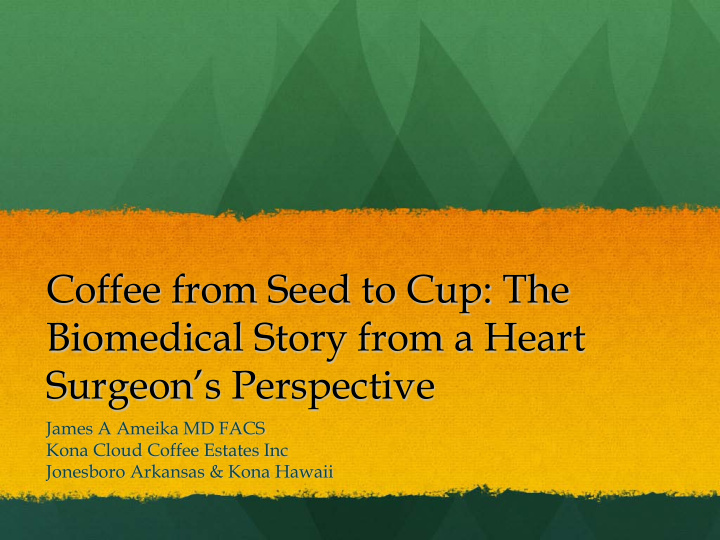



Coffee from Seed to Cup: The Biomedical Story from a Heart Surgeon’s Perspective James A Ameika MD FACS Kona Cloud Coffee Estates Inc Jonesboro Arkansas & Kona Hawaii
Arkansas? Hawaii? Coffee??? Brief Background College and Medical School in Arkansas Army for 13 years Honolulu San Antonio San Francisco Saudi Arabia Jonesboro for the last 19 years
Kona
Hawaii
Kona Beginnings Land Purchased in 1997 Clearing and Planting 1998 First Crop 2000 Roasting 2001 Web development 2003
Why is Kona Great for Coffee? Kona Micro-Climate Warm sunny mornings Cloudy misty afternoons Volcanic well drained soil Frost free growing On the slopes of Mauna Loa (13,696 Feet) 19 Degrees North Latitude
Coffee & Kona Ancestral home of coffee is Ethiopia Coffee origins date to the 1400’s in Yemen Coffee was first planted in Kona in 1828 Original cuttings from Brazil Modern Kona coffee is from Guatemala About 600 farmers 2 Million pounds (1% of world production)
Coffee Growing Optimal Elevation 1500-3500 feet Taxonomy Coffea arabica & Coffea canephora C.arabica is 75 % of worldwide crop C.canephora or robusta is used as a filler Trees can live 75 – 100 years Hand picking every 2-3 weeks
Coffee Pictures
“Kona Coffee has a richer flavor than any other, be it grown where it may, and call it by what name you please” Mark Twain
Roasting Chemistry
Roasting Thermal and Chemical Reactions Occur Pyrolysis Maillard Reaction Carmelization Endothermic Reactions Exothermic Reactions
Major Coffee Acids Quinic Acid Citric Acid Chlorogenic Acid Phosphoric Acid Acetic Acid
Coffee Carbohydrates About 50% by weight of coffee’s dry base Sucrose predominates and varies with ripening. Arabica has 2X the Sucrose of Robusta Mono, oligo and polysaccharides exist
Coffee Proteins Proteins account for 10-13% of dry matter Amino Acid concentrations dependent on stage of ripening Tryptophan, threonine, tyronine, serine, alanine, lysine, and arginine Play a critical role via Maillard Reaction
Coffee Lipids Arabica contains more lipids than Robusta Triglycerides account for 75% Diterpene alcohol esters 18% Deterpene alcohols 0.4% During roasting: lipids and caffeine remain virtually unchanged
Caffeine
Caffeine
Caffeine Chemistry Xanthine alkaloid Isolated in 1820 Molecular Weight 194.19 Arabica 1.2% Robusta 2.2% Concentration in a beverage is dependent on preparation technique Range of 60-150 mg per 8 oz. drink
Trigonelline Slightly bitter alkaloid Important precursor Degrades to the pyridines and nicotinic acid Roasting results in 50-80% loss Majority converted into pyridine Second product is nicotinic acid or niacin Coffee is an ample source of niacin
Medical Aspects of Coffee
Caffeine Metabolism Almost completely metabolized (97%) 75% via 3-N demethylation to paraxanthine 8% via 1-N demethylation to theobromine 8% via 7-N demethylation to theophylline 9% via C-8 hydroxylation to trimethyluric acid
Liver Metabolism
Genetics CYP1A2 is a member of the cytochrome P450 oxidase superfamily in the liver Major regulator of caffeine metabolism Varients exist in rate of metabolism Slow metabolism may be associated with: increased myocardial infarction, hypertension No evidence for elevation of cholesterol and caffeine
Caffeine and Fibrinolysis Fibrinolysis is the breakdown of clot in the body Clot formation is implicated in myocardial infarctions and strokes Regular coffee drinking is associated with increased fibrinolysis Effect not seen in decaf coffee drinkers Clinical significance is unknown
Caffeine & The Respiratory System Asthma is due to reversible airway obstruction secondary to smooth muscle constriction The methylxanthines are smooth muscle relaxant agents Theophylline is 2X more potent than caffeine Caffeine administration has a long history of use in newborns with neonatal apnea
Cancer Coffee contains more than 100 active chemicals No positive correlation between coffee intake and cancer incidence Cafestol and kahweol have been shown to be cancer protective in animal studies Hard to draw any overall conclusions
Weight Loss Caffeine stimulates lipolysis Increases Free Fatty Acid release May lead to enhance fatty acid metabolism in endurance activities Increases basal metabolic rate Appetite suppressant Long term weight maintenance very complicated
Cafestol & Kahweol Diterpene alcohols In vitro: inhibits covalent bonding of aflatoxin to DNA Implicated in elevating cholesterol levels Effect only seen when paper filters are not used
Conclusions
KonaCloudCoffee.Com
Recommend
More recommend